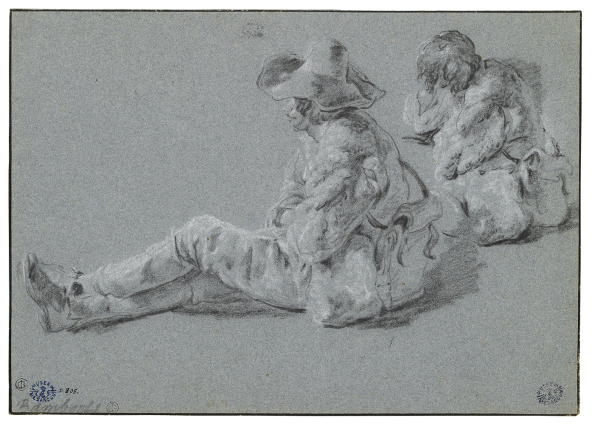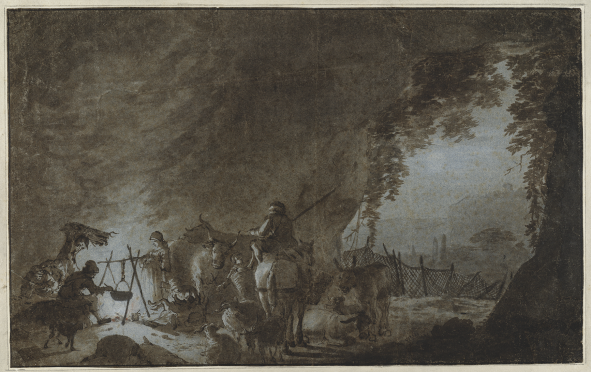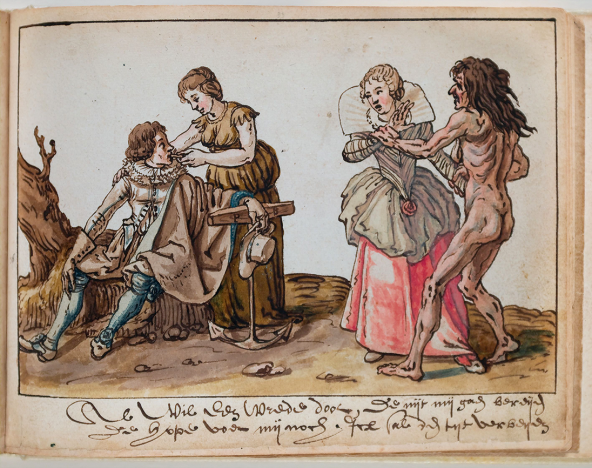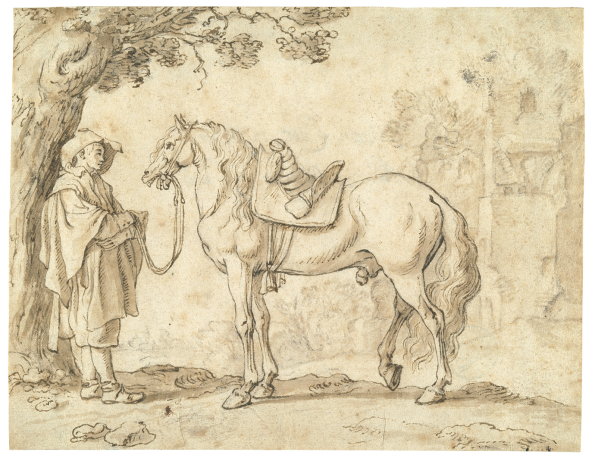Choose a background colour
Attributed to Pieter van Laer, Dutch, 1599-c. 1642
:
Figures Dancing Around a Fire, c. 1635
Pen and brown ink and gray wash on blue paper; framing lines in brown ink.
9 1⁄8 × 11 1⁄4 in. (23.1 × 28.6 cm)
Verso, lower left, in pen and black ink, W.S. (mark of William Sharp); below that, encircled, B157; and in pencil, 63-3.67.
- Watermark:
- None.
- Provenance:
William Sharp, Manchester, mid-nineteenth century (Lugt 2650, mark on verso); sale, Sotheby’s, New York, 29 January 2020, lot 89 (as Pieter van Laer); Sheldon Peck, Boston (Lugt 3847); gift to the Ackland Art Museum, inv. no. 2020.3.
- Literature/Exhibitions:
None
- Ackland Catalogue:
- 2020.3
A leading Dutch painter active in Rome from 1625 to 1637, Pieter van Laer was celebrated for his humorous depictions of contemporary street life. In this spirited carnival scene, masked and costumed figures hold torches and dance around a wicker basket fire at night, the flickering light of the flames vividly reflecting off their bodies. Notice, too, the faint impression of a reveler across the blaze.
Van Laer belonged to a large group of transalpine painters in Rome called the Bentvueghels (Birds of a Feather), but his own talent garnered him a group of followers who called themselves the Bamboccianti, derived from van Laer’s nickname, Bamboccio, or clumsy puppet, a supposed reference to his awkward appearance. Although his drawn body of work is not well defined and followers often copied his drawings, the masterful execution of this sheet supports Van Laer’s authorship.
Despite the rarity of his works today, Pieter van Laer was one of the leading Dutch painters in Rome in the early seventeenth century.1
He was famous not for a grandiose manner, but rather for the opposite: humorous, small-scale genre paintings of contemporary street life that quickly became popular with collectors in Rome and abroad. They also proved influential on a number of artists in his circle, the so-called Bamboccianti, after his nickname, Bamboccio, or “clumsy puppet” due to his supposedly awkward physical appearance.2
Many of these artists, including Van Laer, were among the first generation of members of the famous association of transalpine painters in Rome, the Bentvueghels (“Birds of a Feather”), whose works are notable for their originality.3
We can document Van Laer in Rome between 1625 and 1637, the greater part of his short working career, and back in the Netherlands in 1639, where he settled in Haarlem. According to his sister’s last will drawn up in 1654, Van Laer had left the country again twelve years earlier (1642), and had not been heard from since.4
All trace of him after that point remains lost.
Van Laer’s small drawn oeuvre is not well defined.5
His followers often copied his drawings, and a number of them bear early inscriptions by dealers or collectors attributing the sheet to him (often written as Bamboots) whether or not there is a firm basis for his authorship. This accounts to some degree for the great disparity of styles of drawings currently under his name. Complicating matters further is the story by Arnold Houbraken (1660 – 1719), although its veracity might be questionable, that Philips Wouwerman (1619– 1668) on his deathbed destroyed a large number of Van Laer’s drawings in order to hide the fact that he had been making use of them as preparatory studies for his paintings.6
Intriguingly, one surviving study of a figure on blue paper with an old attribution to Van Laer indeed recurs in a painting by Wouwerman Fig. 13.1.7

Pieter van Laer, Two Studies of a Seated Shepherd, c. 1630 – 37? Black and white chalk on blue paper, 186 × 262 mm. Besançon, Musée des Beaux-Arts et d’Archéologie, inv. no. d805.
Besançon, musée des beaux-arts et d’archéologie. Photograph P. Guenat
As a black and white chalk figure study, its style is obviously quite different from the present work. Somewhat more comparable, given its focus on carefully backlit fi gures around a fi re at night, is the large blue paper drawing in the Teylers Museum Fig. 13.2.8

Pieter van Laer, The Shepherds’ Meal. Pen and brown ink, brown and gray wash, a little red chalk, heightened with white, on blue paper, 269 × 432 mm. Haarlem, Teylers Museum, inv. no. p2.
Teylers Museum, Haarlem, The Netherlands
The artistic challenge of depicting figures around a fi re at night was no doubt appealing, and the use of blue paper for such nighttime fi relit scenes seems to have also occupied Van Laer’s slightly younger Dutch colleague, Jan Asselijn (1610 – 1652), who would have overlapped with him in Rome in the 1630s.9
Despite the obviously looser style and smaller scale of the the present work, the brushwork is remarkably subtle in expressing the effects of the intense, flickering illumination from the bonfire and its reflections on the fi gures. Van Laer cleverly indicated one figure placed on the other side of the fi re with just a few touches of wash and dashes of the pen.
The exuberant execution of the Peck drawing suggests the work of a master rather than a follower or copyist. In support of the attribution to Van Laer are some small, humorous watercolor drawings he made in a personalized Dutch songbook (likely for a woman, who has yet to be identified) from circa 1624 that he must have made just before he left for Italy Fig. 13.3.10

Pieter van Laer, Hope Feeds the Lover, c. 1624. Pen and brown ink and watercolors on paper. Rotterdam, Atlas van Stolk, inv. no. 50641-16.
Atlas Van Stolk, Rotterdam
Their fluid outlines in pen, combined with short, dense strokes for modeling the figures, and the skillful layered brushwork can be found in the Peck drawing as well. The songbook illustrations remain among the very few securely attributed drawings by Van Laer since his monogram or signature appears on a number of them.10
Only two other drawings are known that bear his signature, both showing a rider dismounted from his horse, one in the collection of Universiteit Leiden dated 1625, and another in Hamburger Kunsthalle dated 1628, stating its location as Rome Fig. 13.4.12

Pieter van Laer, Rider and Horse, 1628. Pen and brush in brown ink, over black chalk or charcoal, on paper, 144 × 186. Hamburg, Hamburger Kunsthalle, inv. no. 22093.
bpk Bildagentur/Hamburger Kunsthalle, Hamburg, Germany/Christoph Irrgang/Art Resource, NY
All of these early drawings are more linear in character, with strong outlines in pen as opposed to the more tonal drawings thought to come later. The more refined character of the Hamburg drawing suggests that it was produced from life, while the animated style of the songbook drawings and the present sheet must certainly reflect pure invention. Proposed here is a date in the late 1620s, in the first years after Van Laer’s arrival in Rome when his style seems to have retained some of the same graphic sensibility of the songbook drawings.
These masked and costumed dancers holding torches around a wicker basket fi re are clearly revelers during carnival. As Katharina Weick-Joch pointed out, the Bamboccianti would have been familiar with the visual tradition of carnival scenes from earlier Netherlandish art by Pieter Bruegel and his followers made in the mid- to late sixteenth century.13
Dutch artists could take advantage of breathing new life into that tradition once they had left their Protestant-dominated homeland and arrived in Italy. Van Laer’s contemporary Italian biographer, Giovanni Battista Passeri (1609/10 – 1679), noted his predilection for such themes as “ridiculous pranks of the maskers in carnival time,” leading the art historian Ludovica Trezzani to wonder where they had all gone.14
Indeed, if the attribution of this newly discovered drawing to Van Laer is correct, it might be the only surviving work by him that clearly depicts carnival celebrations.15
Such scenes remained popular with Van Laer’s Bamboccianti followers such as Jan Miel (c. 1599 – 1664) and Johannes Lingelbach (1622 – 1674).16
End Notes
For overviews of Van Laer’s life and art, see L. Trezzani in Briganti et al. 1983, 38 – 77; Cologne & Utrecht 1991 – 92, 188 – 208; D. Levine in Turner 1996; P. Schatborn in Amsterdam 2001, 84 – 87; and Bakker 2017.
For the Bamboccianti, see Briganti et al. 1983; Levine 1984; Cologne & Utrecht 1991 – 92; and Weick-Joch 2015.
J. Verberne in Amsterdam 2001, 22 – 32; and Hoogewerff 1952.
Kurtz 1958, 232.
For recent assessments of Van Laer’s drawings, see A. C. Steland-Stief in Cologne & Utrecht 1991 – 92, 98 – 100; and P. Schatborn in Amsterdam 2001, 84 – 87. The only oeuvre catalogue to date remains Janeck’s 1968 dissertation, in which he only accepts one drawing as authentic (a signed sheet in the Universiteitsbibliotheek Leiden, inv. no. PK-T-AW-474; Janeck 1968, 77 – 78, no. AII1). A few other sheets have come to light in the interim, and others have been generally accepted in the more recent literature; see, for example, Snoep 1968 – 69; Janeck 1976, 297 – 98; Plomp 1997, 219, no. 234; Stefes 2011, vol. 1, 330 – 31, no. 560; and P. Schatborn in Washington & Paris 2016 – 17, 116 – 18, no. 37.
Houbraken 1718 – 21, vol. 2, 75. Piet Bakker made the important point that the Haarlem painter Frederick Vroom (c. 1600 – 1667) also owned two sketchbooks and twenty-one loose sheets by Van Laer, though these appear to have been primarily animal studies and would not necessarily have composed the greater part of Van Laer’s studio leavings; see Bakker 2017.
For this drawing and the related painting by Wouwerman, see P. Schatborn in Washington & Paris 2016 – 17, 116 – 18, no. 37.
See Plomp 1997, 219, no. 234.
See, for example, Asselijn’s two equally large drawings on blue paper, each showing shepherds around a campfire, in the Kupferstich-Kabinett, Dresden, inv. nos. C1517 and C1566; Steland 1989, nos. 54 & 55.
For the songbook and its illustrations, see Snoep 1968 – 69.
Six of the circa 1624 drawings bear a P.B. monogram (for Pieter Boddingh, an early form of his signature), and Snoep attributes three further unsigned drawings to him on the basis of style. After his return from Italy, Van Laer added one more drawing to the songbook, this time signed and dated, P.V. Laer 1641. See Snoep 1968 – 69.
For the Leiden drawing, see Bolten 1985, 154 – 55, no. 58; and for the Hamburg drawing, see Stefes 2011, 330 – 31, no. 560. For a discussion of both, see also P. Schatborn in Amsterdam 2001, 85 – 86 (illustrating additionally Van Laer’s inscription on the verso of the latter).
Weick-Joch 2015, 108 – 09.
L. Trezzani in Briganti et al. 1983, 39. For Passeri’s remarks, see idem, 354 – 55 (citing the 1934 edition edited by Jacob Hess).
There is also a painting in Munich with an uncertain attribution to Van Laer that appears to depict commedia dell’arte fi gures in a tavern, though this work might possibly be a carnival scene; see Cologne & Utrecht 1991 – 92, 193 – 95, no. 19.4.
See Kren 1979, vol. 1, 187; Levine 1984, 289 – 90; Cologne & Utrecht 1991 – 92, 226 – 28, no. 21.9; and Weick-Joch 2015, 98 – 109.
